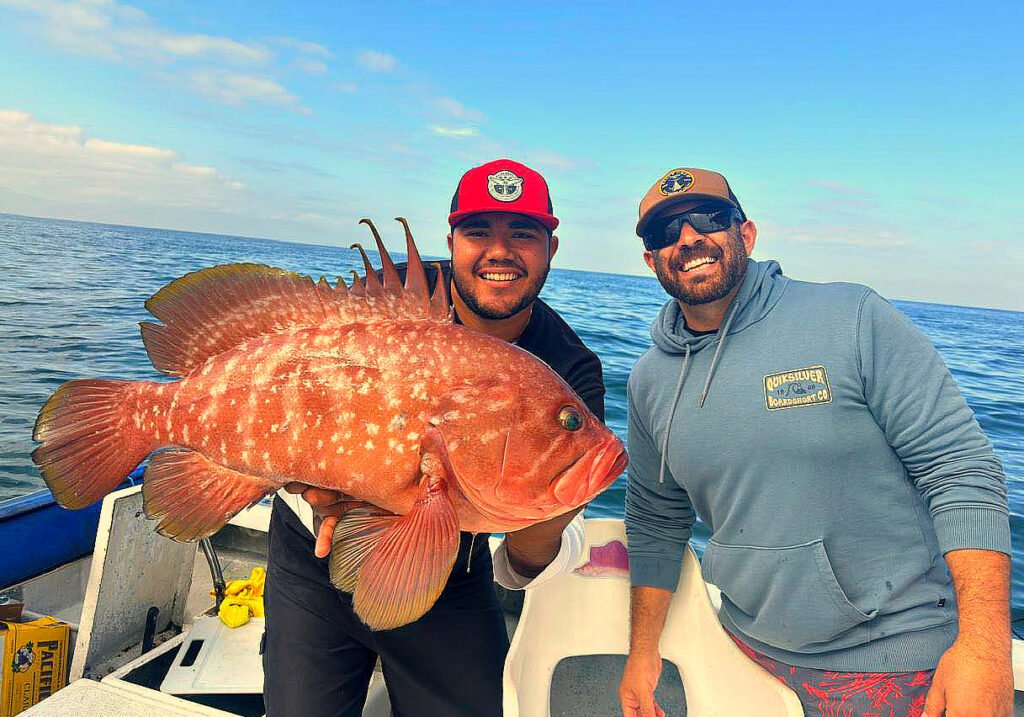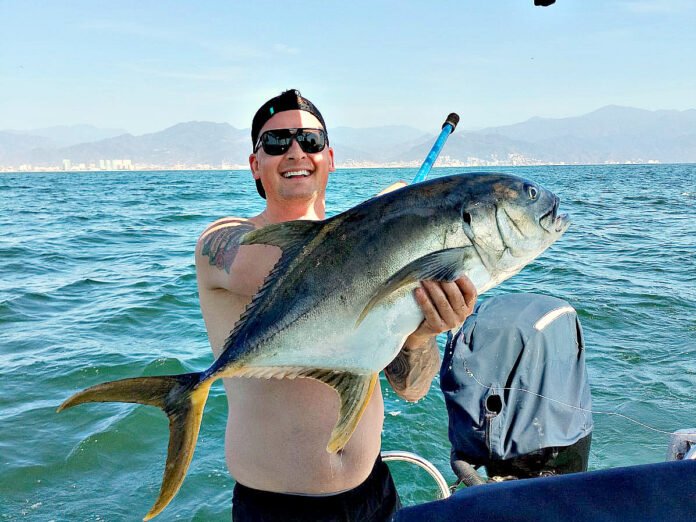After many weeks into the winter season fishing in Puerto Vallarta, we’re still seeing plentiful amounts of summer species – if you’re in the right place at the right time.
El Niño this year has really messed around with our seasonal fishing calendar. Species you would never expect to be available at this time of the year, Dorado, Sailfish, and Striped Marlin to name a few, actually never left the area. So here we are still sending people out after Yellowfin Tuna.
As we slowly move into breeding season, the fishing can be erratic. We can’t get around that, but this isn’t happening much. Remembering we’re still in the winter fishing season, we’re seeing Grouper and other very cold-water species moving into the bay. So stay positive—the fishing is great!
For about four weeks now, we’ve ignored Corbetena because of its lack of action. That changed this week, with Cubera Snapper at 50 lbs. Now, about twelve miles north of the Corbetena rock, you’ll start to run into the Spinner Dolphin and the massive amounts of bait.
From here, commonly known as ‘bottles,’ I refer to this location as the ‘midpoint’ north of the high spots at El Banco. This entire area is your best bang for your fishing dollar. You can still boat Dorado over 30 lbs. Sailfish, Striped Marlin, and Yellowfin Tuna, from 30 to 100 lbs, are running with the Spinner Dolphin.

There are also schools of Yellowfin Tuna, but you need to be at the right place, at the right time when they come up and are frenzied. They can go down just as quickly, so keep an eye out for the birds and the Spinners!
A ten-hour trip can meet the challenge, but I’d suggest the extra two hours so you can move around a bit to find where they went. In ten hours, you hope they’re where ‘you went.’
With Bluewater and massive amounts of bait, water temperatures aren’t an issue. The area from El Morro to Punta Mita is ‘iffy.’ By ‘iffy,’ I mean there are Striped Marlin and Sailfish, but they’re thin in numbers and a little picky when it comes to taking bait. Having said that, we did boat a Striped Marlin this past week, but the day before, the Stripers were just looking, not taking.
There are some larger Jack Crevalles in the area as well, but let’s face it: we can get Jack Crevalles in the bay for a fraction of the cost.
If your heart is set on a Striped Marlin or Sailfish, it’s the second-best location. Bonito are also in the same area in pretty good numbers, but again, you don’t go to the point for Bonito. FYI, if you do give it a shot, drop baits about six miles off the point and troll on a heading from 285 to 310, I suggest 300. Once you’re out about ten miles, anything can happen.
Inside, the bay is unchanged. Jack Crevalles have taken over and are plentiful everywhere. One downside is the Jack Crevalles are in breeding mode. Some days, or I should say, sometimes, they’ll take the bait, and other times, they ignore your presentation. The bottom line is it’s breeding season, and they may not eat in the morning but will in the afternoon.
Remember, we have two ‘bites’ daily, one in the morning and the other in the afternoon. Many times, the afternoon is the better bite. Arctic Bonito, the Bonito we have here in Vallarta, is part of the Tuna family and shouldn’t be considered bait. The Bonito are in the 20 lb. range and more abundant.

The bay is alive with action fishing, great for families or those looking for a shorter-duration fishing trip, yet have plenty of action. Another interesting thing started happening: the Grouper have finally shown up in the bay, and they’re 20 lbs or larger. Snapper will move in, and Sea Bass can’t be far behind.
There are several great locations where these white meat species can be found fairly easily now that they’ve decided to visit the bay, But to be fair, the water temperatures on the surface stay a bit warmer from the sun and currents. But at the depths, the water is cold enough for this limited six to eight weeks window for these cold water species.
Here are some details for the locals: the bite is still about 08:30 in the morning, and I suggest being at your chosen fishing grounds before then. The afternoon bite is happening at 15:00 or about 3 pm for those looking to sleep in a bit.
The bay may be a bit choppy from the afternoon trade winds, but nothing should deter a person unless they’re a sea-sick type. There is plenty of bait, a mix of lures and live bait. Petroleros are always a great choice, but live bait works when they’re taking it. Water temperatures are still 73 to 74 degrees, but you already know the water at depth is considerably colder.
Until next week, don’t forget to kiss your fish!


